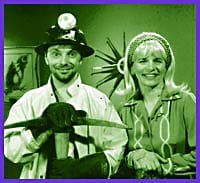Out homos working in a steel mill? Drag cabarets in the boonies? Miners fucking each other miles below ground? What you thought was the gay and lesbian community has just got bigger and stranger.
Downtown Toronto, at the new state-of-the art Paramount Theatre: 42 local filmmakers are featured in Inside Out, one of the world’s largest homo film and video festivals. Forty-two, that’s quite the number of queer cineastes.
But how many of them, if any, are actually from Toronto?
Most gay men and lesbians in Hogtown hail from smaller centres. And that tension between big city film scene and tiny town roots is illustrated in three specific documentaries at this year’s festival: I Know A Place, about growing up gay in Sault Ste Marie; Laugh In The Dark, about a queer family taking root in Crystal Beach; and The PINCO Triangle, about homos in Sudbury.
I Know A Place is a funny, heartfelt documentary about Bob Goddere, one of those amazing (and, until now, unheralded) gay pioneers. Hosting parties and dances in his basement, Goddere gave a home to the homos of the Sault for more than 14 years during the 1970s and ’80s.
But this guy has been out forever. Not only do we get stories of Goddere having sex with his army buddies in World War II and tales of the guys on the line in the Sault steel mill accepting Bob and his boyfriend, Jean-Guy, the film gives real sense of Goddere’s joi de vivre. He his notion of social justice through laughter.
The 30-minute flick is directed by Sault-native Roy Mitchell (whose other productions include more gonzo, guerrilla films like Delta Don). His playful approach to documentary-making meshes perfectly with the precocious Goddere.
Mitchell has also assembled a great sample of old educational films, home footage and clips from classic films. And his use of music keeps things humming along. This is one of those flicks where cheap production values disappear because the story is so well told.
And Mitchell’s presence in the film works surprisingly well; we share his delight in Goddere, and recognize why a community coalesced around him.
Laugh In The Dark opens with a list of people the film is about: “six fags, two dykes and an old lady.” This odd little wagon train pulled into the town of Crystal Beach 20 years ago with the dream of returning the defunct resort town (located 150 klicks from TO) to its former glory, perhaps, even, into a Provincetown of the north.
Opening a bed and breakfast and a restaurant and, to raise money for AIDS, putting on lavish cabaret’s in which the neighbours even participate – against this backdrop, we witness why these seven people form a family and the group’s impact on the unsuspecting locals.
As in I Know A Place, everything comes down to individuals. In Laugh In The Dark, the lynch pin is Gary Colwell an imposing leather/show tune queen and design wizard, who, along with his partner Don Morden, form the group’s nucleus.
First time director Justine Pimlott, a Winnipeg-native (who worked on Maya Gallus’s film Erotica as a sound recordist), is also part of this film, as is her then girlfriend Beth Follet (now an ex); they’re the two dykes. And while their presence can sometimes feel a little forced, it certainly adds a new dimension to this kind of doc – an explicit awareness of group dynamics. This is crucial, for in the second half of the film, the story changes as, one by one, the boys start to die.
This is one of the few films where we see that grief is not just a private burden, but how it spirals out to affect everyone – gay and straight, men and women. As old lady Doris Mehegan observes, not only did they lose their individual friends, they lost their life together – and the dreams they had for Crystal Beach.
Laugh in the dark is a wonderful love letter from and between the members of this chosen family living in the boonies.
(And as if we need more reminders of the impermanence of life, the delightful Doris, who was one of the founders of the AIDS Committee Of Toronto’s library, died while Pimlott was completing the film.)
The PINCO Triangle is an intriguing hodgepodge of a film: interviews with local and dispossessed Sudbury homos, lots of fun archival films, plus a barrage of dramatic segments – kids recreating for a school project the comet that created Sudbury’s geography, fairies skating about the local library….
But there’s a problem. Despite all its extra fireworks, The PINCO Triangle is missing the intimacy and heart found in the other two docs.
We only get flashes of who these people really are – from the woman who returns to Sudbury after feeling alienated and out of place in TO, or from the miner who had tons of sex in the mines.
In the doc about the Sault, there’s a mention of a Mother Brown and Popeye who used to host homo parties in Sudbury. Why aren’t they included in The PINCO Triangle? Instead, directors Ruthe Whiston and Chris Crowe, have included too many free-floating characters who, without sufficient background, come across as too whiny and self-absorbed.
My favourite parts are when people look beyond themselves and talk about Sudbury, itself. It’s amazing how interesting history and politics are when refracted through homo eyes. Similarly, the people featured in I Know A Place and Laugh In the Dark walk us through neat histories of one industry towns.
As for PINCO’s non-documentary footage, some of the bits work better than others. Michael Fitzgerald (aka the Bitch Diva) and Lorraine Segato are surprisingly wooden in their poorly written but wonderfully looking set pieces. At least they shine in the big musical pay off at the end. I won’t give anything away, but it easily makes up for the weaker stuff. And in all, there’s enough laughter and eye-opening info to make The PINCO Triangle well worth watching.
Now, do any of these films make you want to move to Timmins or Kenora?
All of these filmmakers now live in Toronto. And whether they hate or love the small towns they document, they deserve kudos for making fresh the old cliche: We are everywhere.
I Know A Place and Laugh In The Dark are shown in the Canada Is Flaming program (at 9:15pm on Sun, May 23). The PINCO Triangle screens at 4:30pm on Sun May 30.


 Why you can trust Xtra
Why you can trust Xtra


